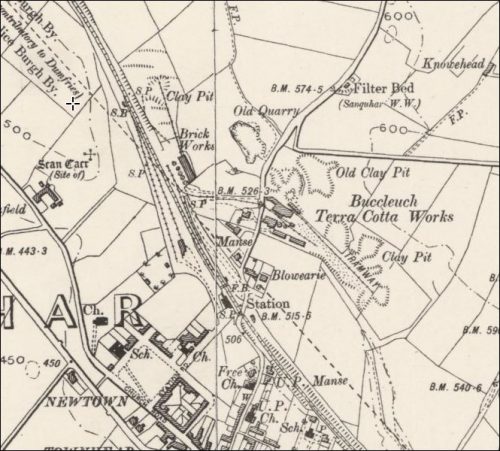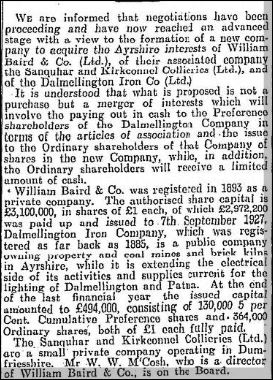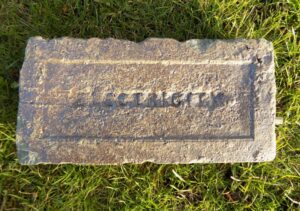Buccleuch Terracotta Works, Sanquhar, Dumfriesshire aka Buccleuch Brick and Tile Works.
(Note – SBH – This page should be read in conjunction with the pages dedicated to the Sanquhar Brick and Tile Works and the Fauldhead Collieries Brick Works)
1962 – The Upper Nithsdale Coalworks from Pictish Times to 1925. Compiled by J C L McConnel – Brickmaking. This industry formed, in later times, a part of the colliery activities in Sanquhar and Kirkconnel and so is included. In the vicinity of Sanquhar, there are deposits of stiff clay. There are still traces of ancient brickworks in that part known as ‘Brickfields’. The earliest notice of the industry is in a letter dated 31/08/1688 from the Earl of Queensberry to his cousin, Douglas of Dornock. – ‘Cusin, some soon as possible wreat to David Reid … that immediately he meit with Wm. Lukup (William Lukup was master of works in Drumlanrig. His four children were buried in Durisdeer Kirkyard in 1685) and cause him to send some of his men to Sanquhar …’ This was to ‘take in’ the chimneys of the Earls chambers ‘which are by a great deal too large’ and prevent them ‘smoaking’. This work was to be done with the ’tile there … and I’ll not be pleased if I find it not done when I come’. Repairs were also made to the ovens in the kitchen and bakehouse.
In 1840, Adam Anderson, 1809 – 1887, who died in Illinois, USA, second son of the blind colliery manager Christopher Anderson, first discovered the potentialities of clay at Gallowbraes, worked later by Clennell.
Older brickmaking was probably intermittent.
The revival of the industry was caused by the growing demand for building bricks and agricultural draining tiles and bricks for both surface and underground colliery uses.
Mr George Clennell, who came from Durham, where he had been employed by a large brickmaking concern, started a brick and tile works in 1852. He installed an extensive plant. As long as the ’tile draining mania’ lasted, trade was good. The works were near to a previous clay working site. Failing trade and lack of capital, however, ended teh venture. The last attempt to work coal near the town was made in 1858 bt Mr Clennell near Mathew’s Folly, no doubt in connection with his lease of the brickfield. It had no success. The council claimed against him for abstracting coal from under the road. It was in making this claim that the serious discovery was made that teh Burgh Charter was lost. Its replacement in 1864 involved the Burgh in considerable expense. Clennel left Sanquhar in 1889 and died in 1900.
A James Brodie took the works over and extended them. These were known as the ‘top’ works. Later they became teh property of Messrs Isherwood Brothers from whom they were purchased by the Sanquhar and Kirkconnel Collieries Limited.
Meanwhile, a lease of the original brickfield, later known as the Buccleuch Works, had been taken over by Mr Matthew McIver from the Duke in 1885. It was over 80 acres in extent, the clay face being 21 feet in height and also a seam of blue clay 4’6″ thick obtained by mining. There was also a mine at the top of the works and teh clay face there too was about 30′ in height in the open surface workings.
McIver was the inventor of the steam drying of bricks. He used the exhaust steam from his engines led under the steel floors of tunnels, the bricks from the presses being loaded on bogies and wheeled in the tunnels. When dry, the bricks were taken to teh kilns and burned in the usual way. This works too was purchased by the Sanquhar and Kirkconnel Collieries Limited. The site can be seen from the railway near Sanquhar station.
Very high-class facing and engineering bricks were produced as well as nearly 200 other clay products. Some of these were coated with enamel, notably insulators, for electrical work at the collieries.
Facing bricks and other products were exported, some as far as British Columbia, Canada.
An order for bricks from Skye inspired a local poet. The lines were published “Speed bonnie brick, like a bird on the wing over the sea to Skye’
The works were purchased in 1925 as part of the assets of the colliery company by Messrs William Baird and Company. By 1960 both were closed and dismantled.
1885 – The Brickworks open. 1885 – 1891 The history of Sanquhar – Buccleuch Terracotta Works – Meanwhile, a lease of the original brickfield, which belongs to the Duke of Buccleuch, had been obtained by Mr M. Mclver, (whose family originated from Ireland.) who proceeded, in the year 1885, to open it up, and to erect the necessary buildings and machinery. The works are similar in size to those above described. Mr Mclver was the inventor of, and the first to introduce, the new process of drying by means of steam, whereby, for the first time, the total ” exhaust ” of the engine is availed of, and distributed over the entire area of the drying- floor, thus securing an equable heat, putting an end to the great waste caused by over-drying, and saving the entire cost of the numerous fires formerly in use for the purpose. Mr Mclver is the lessee of the whole field belonging to the Duke, extending to over eighty acres, the seam of clay being twenty-one feet of surface clay, and a four-and-a-half feet face of blue brick clay in the mine.
Below – 23/09/1885 – Dumfries & Galloway Courier and Herald – Buccleuch Brick and Tile Works, Sanquhar now in full operation. Matthew McIver, proprietor.

09/07/1887 – Dumfries & Galloway Courier and Herald – William Brown, labour and Thomas Maxwell, brickmaker, Sanquhar were charged with having committed a breach of the peace on 28th May at Buccleuch Brick and Tile Works near Sanquhar. They pleaded not guilty. Mr W. T. Craig appeared for Maxwell and Mr J. Blacklock for Brown. Alexander McCall, carter Wanlockhead deponed to going to Clennel’s brickworks for a graip which he had left there on a previous occasion but the youth who had had the graip had removed to Mr McIver’s brickworks. On going there a disturbance took place between Maxwell and Brown and they rolled about the floor. The charge was found proven and each were fined 5s with the option of 3 days imprisonment. His Lordship said it was a great pity that the magistrates of Sanquhar did not act as magistrates when they had the name as a paltry twopenny-halfpenny thing like that could easily have been settled in the police court.
1893 – c. 1907 – The 1985 publication ‘A survey of Scottish brickmarks’ suggests that James Brodie was the owner.
Below – 27/10/1894 – Dumfries & Galloway Courier and Herald – Sanquhar right of way case. Sheriff Substitute’s decision reversed. Matthew McIver.

.

.

08/12/1894 – Dumfries & Galloway Courier and Herald – Mr T. B. Steuart has been unsuccessful in his action to eject Mr Matthew McIver from a roadway leading to his brickworks at Sanquhar.
22/11/1895 – Glasgow Herald – Sanquhar – Fatal accident – Yesterday afternoon, a young man named Joseph Lindsay, resident at Crawick Mill, was so severely crushed by a fall of clay at the Buccleuch Brick and Tile Works, Sanquhar, that he only survived a short time after beg removed home.
Below – 1896 – Sanquhar Brickworks to the left and the larger Buccleuch Terracotta Works to the right.

22/01/1898 – Dundee Courier – New Scottish Company – Buccleuch Terracotta Company, Sanquhar. To take over from Matthew McIver, brick and tile manufacturer, Sanquhar, his lease of clay lands as held from the Duke of Buccleuch and to carry on the business of brick and tile makers. Capital £10,000 in £1 shares.
1901 – Directory of Clayworkers – Matthew McIver, Buccleuch Brick and Tile Works, Sanquhar.
c. 1907 – 1915 – The 1985 publication ‘A survey of Scottish brickmarks’ suggests that Isherwood Bros Ltd were the owner.
14/03/1912 – Aberdeen Press and Journal – Messrs Cotts Forge, the Buccleuch Terra Cotta Limited and the Sanquhar Brick and Tile Company have all closed their works until the strike is settled.
1913 – 1925? Sanquhar and Kirkconnel Collieries Company – Chairman and Managing Director of the Sanquhar and Kirkconnel Collieries Ltd., Dumfriesshire – McConnel, James Irving. Educated at Charterhouse and Edinburgh University. Served apprenticeship in Mechanical Engineering with the Barrow Shipbuilding Corporation. Entered upon lease of the Sanquhar Coalfield in 1886. County Councillor for Dumfriesshire 1892-1922. J.P. Formerly Captain 3rd V.B. Kings Own Scottish Borderers. Member Royal Company of Archers. (Kings Body Guard for Scotland).
Below – 16/09/1914 – Dumfries and Galloway Standard – Accident at the Buccleuch Terra Cotta Company Brick Works. Edward McKie – crushed hand and finger amputated.

20/02/1915 – Dumfries and Galloway Standard – Dangers of gelignite – Charge against a Sanquhar firm – At Dumfries yesterday Sheriff Campion was engaged for several hours hearing evidence in a charge at the instance of Mr Henry Walker, HM Inspector of Mines and Quarries, Edinburgh against the Buccleuch Terracotta Company Ltd, Sanquhar and also against Mr James Pearson Powell, secretary of the company … as owners and manager of the Buccleuch Clay Quarry, Sanquhar … charges involved insufficient notices regarding the quarry safety rules, incorrect storage of gelignite and detonators, thawing out gelignite near a steam boiler while not being in a warming pan … all charges were found not proven.
10/07/1915 – Dumfries and Galloway Standard – A good labourer wanted for clay getting; steady work, good wage. Apply stating age, if married and present work to the Buccleuch Terra Cotta Company Ltd, Sanquhar.
21/08/1915 – Dumfries and Galloway Standard – Men and boys wanted for brickworks. Steady work and good wages. State age and if married. Apply Buccleuch Terra Cotta Co, Sanquhar.
03/11/1915 – Dumfries and Galloway Standard – Women wanted for Brickwork, not under 16 years of age. Apply with references to the Buccleuch Terra Cotta Company Ltd, Sanquhar.
04/12/1915 – Dumfries and Galloway Standard – The Buccleuch Brickworks, which was owned by the Buccleuch Terra Cotta Coy., Ltd., has been acquired the Sanquhar and Kirkconnel Colleries, Ltd. The collieries now own both brickworks. (Sanquhar Brick and Tile Works and the Buccleuch Terracotta Works, both in Sanquhar). Their latest acquisition is situated close to the railway, and a high class of brick is manufactured there, which commands a ready sale. Both works are extremely busy at present; a large quantity of their bricks being used at Gretna.
04/04/1916 – Edinburgh Gazette – The Buccleuch Terra Cotta Company Limited. Notice is hereby given that, in pursuance of Section 188 of the Companies (Consolidation) Act, 1908, a Meeting of the Creditors of the above-named Company will be held within the Office of Thomson McLintock & Co., C.A., 149 West George Street, Glasgow, on Friday the 14th day of April 1916, at 12 o’clock noon. William McLintock Liquidator.
08/04/1921 – The Scotsman – Harmony in Dumfriesshire – A spirit of harmony prevails in the Sanquhar and Kirkconnel districts. The staff and clerks are managing to keep the mines clear. Other industries are, however, beginning to feel the effects, and a considerable number of men and women have been compelled to cease work at the local brickworks for the lack of fuel. This is regrettable, as there is a great demand for bricks. This stoppage will affect the progress of the local housing scheme.
Below – 1922 – Sanquhar & Kirkconnel Collieries letterhead – Enquiry dated 13/10/1922 to Wm Forsyth Esq, Town Clerk, Sanquhar for 8 panel paving bricks at 130/- per 1000 and signed J Gordon. Sanquhar & Kirkconnel Collieries owned the Fauldhead Collieries Brickworks and at one point the Sanquhar Brick and Tile Works and the Buccleuch Terracotta Works, Sanquhar.

.

11/02/1924 – The Scotsman – … It is interesting to state that it is exactly 100 years since the grandfather of the chairman of the Sanquhar and Kirkconnel Collieries ( Limited ) procured a lease of the minerals from the Duke of Buccleuch and Queensberry, and without a break, the family have continued to operate on the coal seams and the fireclay utilised in connection with the brick, tile, and terracotta works.
1925 – 1931 – William Baird & Co Ltd ran the Buccleuch Terracotta Works – Source Brick, Tile and Fireclay Industries in Scotland RCAHMS. (Note – SBH – I would imagine this included the Fauldhead Colliery Brickworks and the Sanquhar Brick and Tile Works).
1931 – 1947 – The Baird and Dalmellington Iron Company Limited ran the Buccleuch Terracotta Works – Source Brick, Tile and Fireclay Industries in Scotland RCAHMS. (Note – SBH – I would imagine this included the Fauldhead Colliery Brickworks and the Sanquhar Brick and Tile Works)
Below – 11/07/1931 – The Scotsman – New Scottish merger – Coal and iron interests. The Dalmellington Iron Company take the Sanquhar and Kirkconnel Collieries from William Baird and Co.

25/04/1933 – Dundee Evening Telegraph – Arbroath High School extension … the outer walls are built of Brechin stone, the inner walls to dado height, of Buccleuch brick and adobe dado height of Montrose brick …
29/03/1938 – The Scotsman – Bairds and Dalmellington Limited – Favourable results of years trading … other major items of capital expenditure included … the erection of an aerial ropeway to handle supplies of material for the Dalmellington Brickworks. We also completed an extension to our Buccleuch Terracotta Brickworks, Sanquhar … the brickworks were actively employed throughout most of the year, though during December there was a slackening in demand due to weather conditions interfering with building operations …
04/01/1939 – Dumfries and Galloway Standard – New cinema for Kirkconnel – Sanquhar and Kirkconnel bricks were used for the erection of the building … (Note SBH – I am uncertain if these were bricks from the Fauldhead Colliery Brickworks or the Sanquhar Brick and Tile Works or the Buccleuch Terracotta Works).
13/04/1939 – The Scotsman – The Buccleuch Brick Works were idle yesterday due to a failure in their water supply.
25/09/1940 – Dumfries and Galloway Standard – Short time at Sanquhar Brickworks – The employees of Sanquhar Buccleuch Brickworks, owned by Bairds & Dalmellington, Ltd., are presently on short time. Last week they worked the first three days and were idle the last three. A superior class of bricks is manufactured at this works and apparently, the demand for these has slackened off.
14/04/1945 – Dumfries and Galloway Standard – Sanquhar Town Council meeting. The Provost reported that the proposed refuse coup at the top Brickwork was not available because Messrs Bairds & Dalmellington intended to excavate clay from it, but representatives of the company had generously offered another site beyond the low Brickwork, which he, with Treasurer Tweddel and the town clerk had examined, and they considered it very satisfactory in every way. It was well removed from any habitation and would last for several generations. Treasurer Tweddel said that it was an ideal place and might last for 100 years. It was decided to negotiate with the Colliery Company with a view to acquiring this site.
1947 – 1958 ( 1961) The National Coal Board ran the Buccleuch Terracotta Works (Brickworks closed 1958 – 1961) – Source Brick, Tile and Fireclay Industries in Scotland RCAHMS. (Note – SBH – Has anyone ever seen a brick marked NCB Sanquhar?).
c. 1971 – Works demolished.
Information – Buccleuch Brickworks, Sanquhar, Dumfries & Galloway This shows the two southernmost kilns from the north-west. The one on the right still has its superstructure, and the bricks on top of the other are the remains of its cone. The moulding shop is in the background. The arches in the bases of the kilns are the fire holes. These works closed in about 1958 but was still reasonably intact in the mid-1960s. By 1971 the kilns had been almost completely demolished, and since then the rest of the complex has also gone. Terracotta bricks were popular as they were non-porous, and did not retain soot on their surfaces. These works were established in about 1889 to make terracotta bricks. It consisted of a large moulding shop and eight large round downdraught kilns, all of which had conical superstructures, probably later additions. The clay came from quarries to the north-east and south-east on narrow-gauge tramways
Below – Unknown date – Buccleuch Terracotta Brick Works, Sanquhar. Source


















